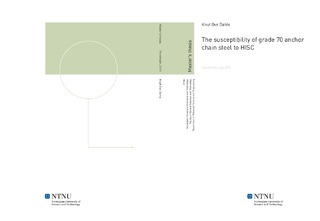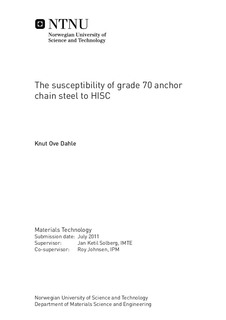| dc.contributor.advisor | Solberg, Jan Ketil | nb_NO |
| dc.contributor.advisor | Johnsen, Roy | nb_NO |
| dc.contributor.author | Dahle, Knut Ove | nb_NO |
| dc.date.accessioned | 2014-12-19T13:26:03Z | |
| dc.date.available | 2014-12-19T13:26:03Z | |
| dc.date.created | 2012-04-20 | nb_NO |
| dc.date.issued | 2011 | nb_NO |
| dc.identifier | 517098 | nb_NO |
| dc.identifier | ntnudaim:6655 | nb_NO |
| dc.identifier.uri | http://hdl.handle.net/11250/248987 | |
| dc.description.abstract | Due to recent fractures in grade 70 anchor chains in the fish farming industry, chain supplier Erling Haug AS has initiated an examination of a sandblasted anchor they sell today. The sandblasted anchor chain is of the same strength category as the chains associated with the mentioned accidents. The mechanical properties of the sandblasted chain were characterized in 2010 in a student project work[1]. The report expressed concern about the sandblasted grade 70 chains since the material fulfilled requirements to be susceptible to hydrogen induced stress cracking (HISC). Therefore, further research on the material was needed. Another grade 70 chain, of an unknown origin, was obtained to make a comparison. This chain had fractured in-service. It was therefore necessary to characterize the mechanical properties of the fractured chain before examining the two chain grades susceptibility to HISC. The fractured chain was examined in terms of its microstructure, hardness, transition temperature and strength. An attempt was made to explain why the fractured chain failed in-service.The tensile test of the fractured chain revealed that its yield strength was 140MPa lower than that of the sandblasted chain. It was considered possible that the fracture chain were weaker than they should have been and that the reason it failed in-service was due to overload.The susceptibility of the two chains to HISC was tested by submerging tensile specimens into a 3.5% NaCl solution in CorTest Proof rings, while exposed to hydrogen. Specimens were either hot dip galvanized (HDG), protected by an external potential of -1050mV vs. Ag/AgCl or freely exposed at their corrosion potential. Some specimens were pulled in steps till fracture, while others were held at a constant load for 14 days.Different loading and corrosion potentials were applied to the two chain qualities during the HISC test, but the experiment was unable to provoke brittle fractures in either of them. No cracking was observed in the SEMivfor any of the HDG tensile specimens. It was found that hydrogen have no influence the mechanical properties of the HDG tensile specimens, while hydrogen appear to assist in the development of cracks on the polarized specimens. | nb_NO |
| dc.language | eng | nb_NO |
| dc.publisher | Institutt for materialteknologi | nb_NO |
| dc.subject | ntnudaim:6655 | no_NO |
| dc.subject | MIMT Materialteknologi | no_NO |
| dc.subject | Materialutvikling og -bruk | no_NO |
| dc.title | The susceptibility of grade 70 anchor chain steel to HISC | nb_NO |
| dc.type | Master thesis | nb_NO |
| dc.source.pagenumber | 124 | nb_NO |
| dc.contributor.department | Norges teknisk-naturvitenskapelige universitet, Fakultet for naturvitenskap og teknologi, Institutt for materialteknologi | nb_NO |

